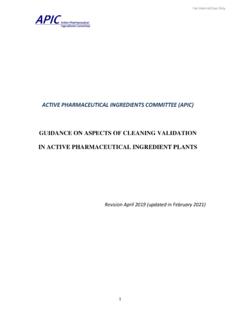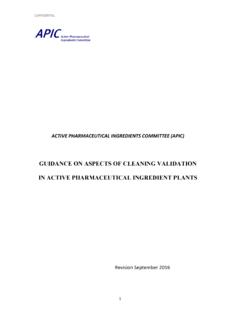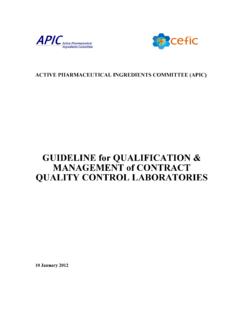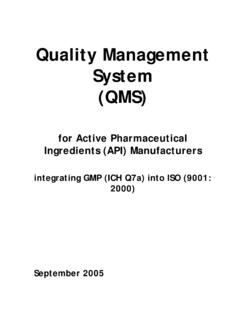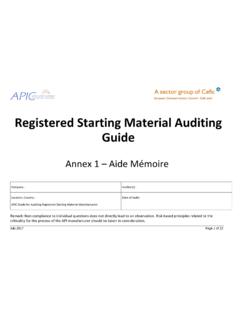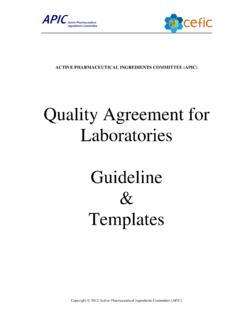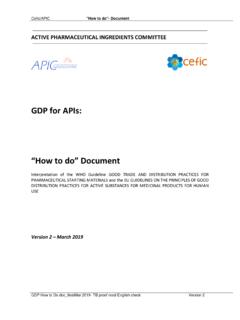Transcription of Practical risk-based guide for managing data integrity
1 1. ACTIVE PHARMACEUTICAL INGREDIENTS COMMITTEE. Practical risk- based guide for managing data integrity Version 1, March 2019. 2. PREAMBLE. This original version of this guidance document has been compiled by a subdivision of the APIC Data integrity Task Force on behalf of the Active Pharmaceutical Ingredient Committee (APIC) of CEFIC. The Task Force members are: Charles Gibbons, AbbVie, Ireland Danny De Scheemaecker, Janssen Pharmaceutica NV. Rob De Proost, Janssen Pharmaceutica NV. Dieter Vanderlinden, Ajinomoto Omnichem Andr van der Biezen, Aspen Oss Sebastian Fuchs, Tereos Daniel Davies, Lonza AG. Fraser Strachan, DSM. Bjorn Van Krevelen, Janssen Pharmaceutica NV. Alessandro Fava, (Fabbrica Italiana Sintetici) SpA. Alexandra Silva, Hovione FarmaCiencia SA.
2 Nicola Martone, DSM Sinochem Pharmaceuticals Ulrich-Andreas Opitz, Merck KGaA. Dominique Rasewsky, Merck KGaA. With support and review from: Pieter van der Hoeven, APIC, Belgium Francois Vandeweyer, Janssen Pharmaceutica NV. Annick Bonneure, APIC, Belgium The APIC Quality Working Group 3. 1 Contents 1. General Section .. 4. Introduction .. 4. Objectives and Scope .. 5. Definitions and abbreviations .. 5. Overall Data integrity Approach .. 6. 2 Business Processing Mapping .. 9. 3 Data and System Identification .. 10. 4 Data and System 11. Data Severity Assessment .. 11. System Profiling .. 12. System categorization .. 12. System categorization requirements .. 14. System Assessment .. 17. 5 Risk Assessment .. 33. 6 Risk 36. 7 References.
3 38. 8 Examples .. 39. Production Systems and Process Risk Assessment .. 39. Laboratory Systems and Process Risk Assessment .. 48. 4. 1. General Section Introduction Data integrity refers to the accuracy, completeness and consistency of GxP data over its entire lifecycle. The steps that need to be overseen include the initial generation and recording, the processing (incl. analysis, transformation or migration), the outcome/use, the retention, retrieval, archive and finally the destruction. Data integrity means that all the steps defined above are well managed, controlled and documented and therefore the records of the activities follow the ALCOA principles described in the guidelines. The ALCOA and ALCOA+ principles have been in place for several years in the industry and are widely known and implemented.
4 Achieving data integrity compliance, for paper, electronic and hybrid systems, requires translation of these principles into Practical controls in order to assure GxP- impacting business decisions can be verified and inspected throughout the data lifecycle. Currently available regulatory guidelines have been used to elaborate the approach outlined in this Practical guide (see also section 7, References). The current guidelines on data integrity require that companies complete data integrity criticality and risk assessments to ensure that the organizational and technical controls that are put in place are commensurate with the level of risk to quality attributes. The guidelines emphasise the importance of creating and maintaining a working environment and organisational culture that supports data integrity .
5 Companies should establish data governance programs that address technical, procedural and behavioural aspects to assure confidence in data quality and integrity . This document will not describe all the elements required for a data governance program in detail. However, some foundational principles are given below: Organisational Culture Organisational culture has the potential to increase the possibility for lapses in data integrity ;. intentional ( fraud or falsification) or unintentional ( lack of understanding of responsibilities and/or requirements). To reduce this potential, organisations should aspire to an open culture where subordinates can challenge hierarchy, and full reporting of a systemic or individual failure is a business expectation.
6 Awareness It is crucial that employees at all levels understand the importance of data integrity and the impact that they can have on GxP data with the authorisations assigned for their job roles. Training is a major component of raising awareness and should be conducted periodically. The ALCOA+ concepts, and the acronym itself, are widely used by regulators and industry and should be incorporated into the program ( within staff training, policies etc.). System and Process Design Compliance with data integrity principles can be encouraged through the consideration of ease of access, usability and location. For example: o Control over blank paper templates for GxP data recording o Control of spreadsheets used for calculations o Access to appropriate clocks for recording timed events o Accessibility of records at the locations where activities take place 5.
7 O User access rights and permissions that align with personnel responsibilities o Automation of GxP data capture where possible o Access to electronic GxP data for staff performing data review activities Management Commitment Senior management should ensure that there is a written commitment to follow an effective quality management system and professional practices to deliver good data management. The commitments should include An open quality culture Data integrity governance Allocation of appropriate resources Data integrity training for staff Monitoring of data integrity issues with CAPA taken to address issues identified Mechanisms for staff to report concerns to management Objectives and Scope This document is based on general Data integrity requirements and gathers Practical experiences from a number of companies operating in the sector that can be used as guidance to others.
8 It is not an all- inclusive list of requirements but proposes a comprehensive approach that companies can adopt to help carry out their data integrity risk assessments. The guide is essentially Practical and therefore, after the presentation of the approach and of the tools, the document includes some examples of executed assessments, categorisations and check lists that can be used by any company according to their individual needs. Each company can choose the appropriate tools and categorisations that apply to their own business processes and systems. This guidance applies to all GxP processes and GxP data used in the manufacture and analysis of APIs for use in human and veterinary drugs. Definitions and abbreviations Business process: a set of structured activities or tasks that produce a specific service for a particular customer or customers.
9 It is often visualised as a flowchart of a sequence of activities with decision points. Data: Facts, figures and statistics collected together for reference or analysis. All original records and true copies of original records, including source GxP data and metadata and all subsequent transformations and reports of these GxP data, that are generated or recorded at the time of the GxP activity and allow full and complete reconstruction and evaluation of the GxP activity. Raw data: Raw data is defined as the original record (data) which can be described as the first-capture of GxP. information, whether recorded on paper or electronically. Information that is originally captured in a dynamic state should remain available in that state.
10 Metadata: Metadata are data that describe the attributes of other data and provide context and meaning. Typically, these are data that describe the structure, data elements, inter-relationships and other characteristics of data audit trails. Metadata also permit data to be attributable to an individual (or if automatically generated, to the original data source). 6. Data severity assessment: within GxP data, different levels of severity can be defined as a function of its use. Typically, this is linked to the stage of manufacturing following the principle of increasing GxP outlined in ICH. Q7. Alternatively, other factors such as impact on final product quality can be taken into account to further differentiate between severity categories.
